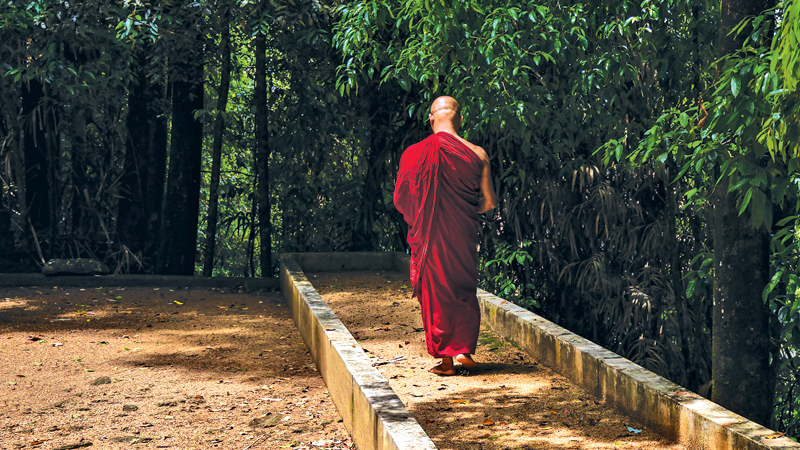A contemplative community at the Bodhinagala forest hermitage makes surroundings perfectly suited to the age-old art of meditation.
The Bodhinagala forest hermitage at Dombagaskanda off Ingiriya shelters underneath the dim and leafy canopy of a wet zone tropical rain forest reservation of 347 hectares. The natural forest insulates the retreat from the sights and sounds of the outside world, providing an ideal setting for meditation practised there.
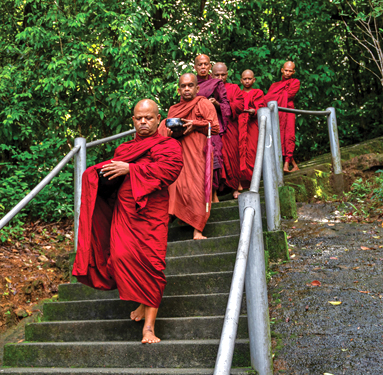
Meditative bhikkhus walk silently in a single file, each carrying the alms bowl, down the pathway on ‘pindapatha’ for mid-day Dana at the Bodhinagala hermitage
A group of bhikkhus clad in dark brown robes walked in a single file, carrying their alms bowls covered with the robes, silently down the pathway for the midday dana under a dimly lit forest canopy. After their bowls were taken by devotees at the entrance, they moved to seats arranged in the hall and patiently sat until the devotees served the dana into their bowls, chanting Sadu… Sadu…
Female devotees gathered at a corner of the Dana Salawa (alms hall), clasping their hands together in worship. Then the bhikkhus retired to another alms hall a little distance away where they partake of the food they received. One bhikkhu stayed in the Dana Salawa to confer merit on the devotees who had served alms. This is a moment in the daily routine of the forest-dwelling monastic bhikkhus of the Bodhinagala forest hermitage.
The hermitage, a complex of 12 cells and a rock cave, a small shrine inside a stupa, an alms hall, a refectory and a kitchen, sits astride a saddle of rock boulder, reached by a rock-cut flight of steps, a serpentine path and a stairway of neatly steps. Towering trees and forest canopy at its foot drench the air with a delusively sensuous fragrance; all else is austere and full of challenges.
Each cell or ‘Kuti’ has a door and a window, a narrow bed, a table, a low stool, some pictures of the Buddha and an electric light. A firewood hearth is provided for making tea and hot herbal drinks. A paved walkway is just outside the cell for ‘Sakmam Bhavana’ – meditative walking.
Organised time-table
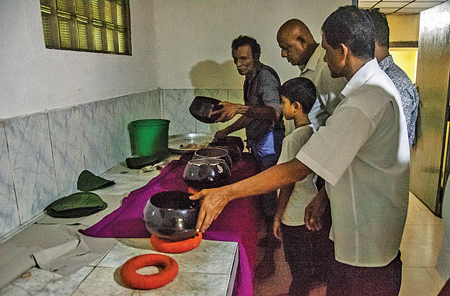
Devotees prepare alms in bowls for the bhikkhus in the Dana Salawa
The day at the hermitage begins in the darkness before daybreak, and consists a closely organised time-table of meditation, study, instruction, worship and chanting of sacred pirit litanies until 10pm. An insight meditation ‘Anapanasathi’ sitting usually lasts one and a half to two hours at a time, twice a day. Advanced practitioners who due to the high levels of mental relaxation they have achieved need little sleep and meditate late into the night. The daily program also includes a few domestic duties.
Meticulous personal cleanliness is required, so the hermitage schedule includes a daily bath. The bhikkhus dress in a deep brown habit, symbolic of their renunciation of the world, and observe contemplative decorum in all activities, silence and solitude.
Two main meals at the hermitage – breakfast and lunch –are provided by alms donors; the bhikkhus receive food in their begging bowls and confer merit on the donors. Begging for food, or ‘pindapatha’, is also facet of the renunciation of worldliness inherent in forest-dwelling Buddhist monastic life.
Although the fare is simple and almost purely vegetarian, great care is taken in the preparation and presentation, as giving alms to bhikkhus is rated high on the ‘good work’ scale of the Buddhist. A hot porridge made with rice, coconut cream and fresh green herbs are always a staple for heel dana as breakfast is called, together with ricemeal hoppers (pancakes) and chilli relish.
Lunch is rice with vegetables, pulses and sometimes vegetable chutneys, with perhaps fresh fruits or curd and palm treacle to follow. Bhikkhus abstain from having solid food after midday; herbal or black tea is served in the evening. “On the very rare occasions when no alms are available, I prepare breakfast of herbal porridge here in the hermitage kitchen,” the caretaker said. Luncheon is rice, two vegetarian curries and a good coconut gravy. “If any donor is unable to offer alms on his assigned day, I asked one of our well-wishers to prepare alms for the day,” Ven. Miriswatte Naradha Thera told me when I inquired about daily alms offerings.
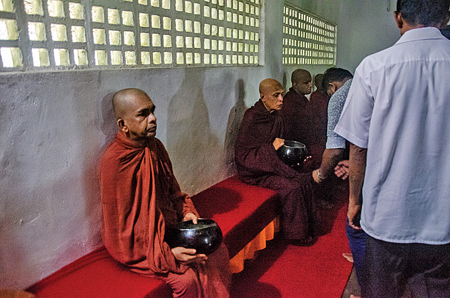
Devotees serve alms-filled bowls to meditative bhikkhus
The daily program of vipassana dhura bhikkhu is mainly a contemplative one, in which ‘vipassana bhavana’ (insight meditation) is dominant, central theme and experience. Insight meditation employs many techniques and subjects, one of the most widely used being anapanasati, the concentration on rhythmic inhalation and exhalation of breath. These communities live mostly in secluded woodland hermitage complexes (aranya), in rock shelters, caves, cob huts or cells, collectively called kutis.
Insight meditation
Each day at the hermitage comprises a closely structured balance of mind development, concentration and awareness exercises, food, drink, rest and sleep, solitude, silence, study, worship and instruction. In the meditative process, specific activities of the mind and body are explored and worked within a personal, inward journey towards contact with the universal truths and Buddhist virtue.
The austerity of this regiment is also very healthy. Many beneficial side effects stem from a serene environment, cleansing the mind of tension, stress, worry, guilt, anger and evil thought, helping to balance the proper functioning of blood circulation, the nervous system and vital organs in the process. This is borne out by evidence that most bhikkhus who follow meditative routines live in good health to an advanced age.
The procedure of offering alms sees a donor selected for each day of the year. The chief donor together with relatives and friends offers alms to the bhikkhus on the day assigned to him. Some would come to the hermitage the previous evening and stay overnight at the Giman Hala (resting hall) to prepare the morning breakfast and lunch which would be offered the following day. Most donors are from nearby places while some are from faraway places around the country.
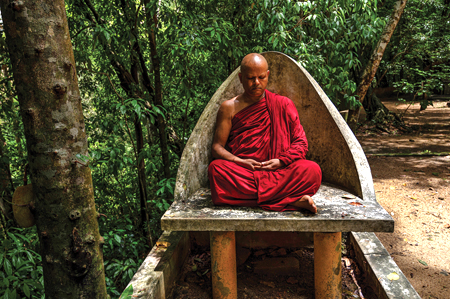
A bhikkhu meditates on a seat built an open space near his kuti under a forest canopyA bhikkhu meditates on a seat built an open space near his kuti under a forest canopy
I am writing this story not to attract large crowds and not to disturb the silence and solitude at the hermitage, but to tell the world that such a calm and quite tranquil hermitage exists here practising the Buddha’s doctrine.
Reaching the foot of the Dombagaskanda, you will find the natural forest reserve and a notice board beside the road cautioning visitors not to damage or disturb the fauna and flora in the protected area. It also directs you to the road leading to the hermitage.
Although it was a sunny day when we arrived at the forest reserve, we heard the sound of rain. Further up, we noticed that it was not rain, but the sound of a stream flowing across the mountain.
We also had a glimpse of the Kalu Ganga which flows along the foot of the forest reserve. The silence of this serene and undisturbed forest is occasionally broken by the sound of a hornbill or monkey.
About 12 bhikkhus reside permanently at the hermitage, while foreign bhikkhus too come for short periods to practise meditation. To avoid disturbing the meditative bhikkhus, visitors are allowed into the area of kutis only from 12 noon to 1pm.
An interesting feature of the hermitage is the ‘Gediya’, wooden gong, the short tree trunk. When beaten with a stick, it emanates a loud sound. It’s hung on a tree and is sounded around 10.00 am every day to call the bhikkhus of the hermitage to the main Dana Salawa from where they go on Pindapatha.
The history of the Bodhinagala forest hermitage goes back to the early 1950s. Ven. Olaboduwe Sri Revatha Dhamma Kithti Thera, the Principal of the Dharmadeepa Vipassana Piriwana, Kaluwamodara in Aluthgama was the founder of the Bodhinagala forest hermitage. He came to Ingiriya to observe Vas on the invitation of devotees in the Raigam Korale.
Initial makeshift hut
He stayed in a makeshift hut at a cemetery close to the Ingiriya hospital with seven bhikkhus. More people thronged Ingiriya to listen to the Dhammadesana and meditation practices conducted by the Ven. Thera. After the Vas season was over, the bhikkhus prepared to go back, but the devotees persuaded them to stay permanently.
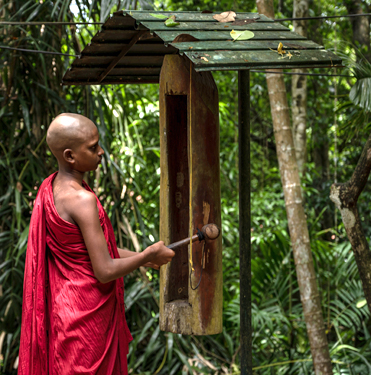
A novice sounds the hollow, wooden gong, struck to signal four separate times on bhikkhus’ day
Ven. Olaboduwe Sri Revatha Thera, with the help of a few villagers, visited the thick forest of Dombagaskanda and at first sight, realised it was ideal for a forest hermitage. The villagers and devotees in the Raigam Korale have constructed the Kutis and other buildings in the Dombagaskanda forest and on June 4, 1955, the complete hermitage of Bodhinagala was offered to the Sangha.
Initially, six bhikkhus lived in kutis in five acres of forest. Later, it was expanded to 50 acres during the time of the late M.D.H. Jayawardena, the then MP for Horana. Today, this hermitage has numerous constructions including kutis, meditative pathways and medical halls, linked together and developed as a reputed forest hermitage in the country.
After the passing away of Ven. Olaboduwe Sri Revatha Thera, then Ven. Miriswatte Abhaya Revatha Thera became the Senasanadipathi of the hermitage. Today, the hermitage is administrated by its chief incumbent, Ven. Labugama Ananda Dhamma Kithti Thera whose serenity, mental clarity and spiritual depth reflect long schooling in meditative discipline.
We left the hermitage, with joy in our hearts, having witnessed its serenity. The happiness we enjoyed, spending a few hours under the canopy of green, away from the sights and sounds of the outside world, was more than words can express.







